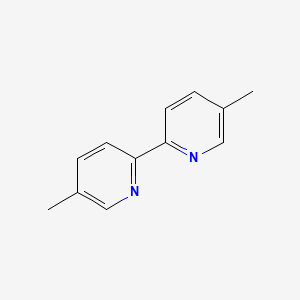



API Suppliers

US DMFs Filed

CEP/COS Certifications
0

JDMFs Filed
0
Other Certificates
0
Other Suppliers
0

USA (Orange Book)

Europe
0

Canada
0

Australia
0

South Africa
0
Uploaded Dossiers
0
U.S. Medicaid
0
Annual Reports
0
0


1. 5,5'-dimethyl-2,2'-bipyridyl
2. Dmbp Cpd
1. 1762-34-1
2. 5,5'-dimethyl-2,2'-bipyridine
3. 5,5'-dimethyl-2,2'-dipyridyl
4. 6,6'-bi-3-picoline
5. 5,5'-dimethyl-2,2'-bipyridyl
6. Xeglyze
7. Ha-44
8. 2,2'-bipyridine, 5,5'-dimethyl-
9. 5-methyl-2-(5-methylpyridin-2-yl)pyridine
10. Brn 0123183
11. 6,6'-di-3-picolyl
12. 6,6'-di-3-picoline
13. Ha44
14. 6uo390amfb
15. Chembl2205807
16. 5,5'-dimethyl-2,2'-bipyridinyl
17. Mfcd01740554
18. Abametapir [usan:inn]
19. Unii-6uo390amfb
20. Xeglyze(abametapir)
21. Xeglyze (tn)
22. Abametapir [mi]
23. Abametapir [inn]
24. Abametapir (usan/inn)
25. Abametapir [usan]
26. Abametapir [who-dd]
27. Schembl351152
28. Yssj3184
29. 2,2 -bis-(5-methylpyridyl)
30. Abametapir [orange Book]
31. Dtxsid00170095
32. Chebi:192617
33. Zinc403335
34. Bdbm50401351
35. Lt0042
36. S5752
37. 5,5''-dimethyl-2,2''-bipyridine
38. Akos005257775
39. Cs-w004546
40. Db11932
41. Hy-w004546
42. Sb17220
43. 5,5'-dimethyl-2,2'-dipyridyl, 98%
44. Ds-15219
45. Sy052805
46. Ft-0689891
47. D10687
48. D70523
49. W-108621
50. Q27265547
51. 5,5 Inverted Exclamation Mark -dimethyl-2,2 Inverted Exclamation Mark -bipyridyl
| Molecular Weight | 184.24 g/mol |
|---|---|
| Molecular Formula | C12H12N2 |
| XLogP3 | 2.2 |
| Hydrogen Bond Donor Count | 0 |
| Hydrogen Bond Acceptor Count | 2 |
| Rotatable Bond Count | 1 |
| Exact Mass | 184.100048391 g/mol |
| Monoisotopic Mass | 184.100048391 g/mol |
| Topological Polar Surface Area | 25.8 Ų |
| Heavy Atom Count | 14 |
| Formal Charge | 0 |
| Complexity | 161 |
| Isotope Atom Count | 0 |
| Defined Atom Stereocenter Count | 0 |
| Undefined Atom Stereocenter Count | 0 |
| Defined Bond Stereocenter Count | 0 |
| Undefined Bond Stereocenter Count | 0 |
| Covalently Bonded Unit Count | 1 |
Abametapir is indicated, in the context of an overall lice management program, for the topical treatment of head lice infestation in patients 6 months of age and older.
Abametavir has been shown to inhibit all stages of embryo development in both head and body lice by interfering with enzymes critical to this process. It is relatively unique amongst lice treatments in that it requires only a single application, whereas many current therapies require two applications, due to its exceptional potency and unique mechanism. Its predominant metabolite, abametapir carboxyl, has a prolonged residence time in the body, with an estimated half-life of 71 40 hours or longer in adults - as this metabolite has been shown to inhibit cytochrome P450 enzymes _in vitro_, the use of substrates of CYP3A4, CYP2B6, or CYP1A2 should be avoided for two weeks following the administration of abametapir. Abametapir lotion is formulated with [benzyl alcohol], which has been associated with significant toxicity following unintentional systemic exposure, particularly in neonates and low birth weight infants. Benzyl alcohol-containing formulations should not be administered to patients <6 months of age, and should be administered to pediatric patients cautiously and under direct supervision of an adult to mitigate the risk of unintentional oral ingestion.
P - Antiparasitic products, insecticides and repellents
P03 - Ectoparasiticides, incl. scabicides, insecticides and repellents
P03A - Ectoparasiticides, incl. scabicides
P03AX - Other ectoparasiticides, incl. scabicides
P03AX07 - Abametapir
Absorption
In a pharmacokinetic trial with both adult and pediatric patients, the Cmax and AUC0-8h in the adult group were 41 ng/mL and 121 ng.h/mL and the Cmax and AUC0-8h in the pediatric group were 73 ng/mL and 264 ng.h/mL. In general, systemic exposure to abametapir appears to decrease with increasing age. The median Tmax of abemetapir is 0.57 - 1.54 hours. Following topical administration, benzyl alcohol was found in detectable quantities in the serum of 7 out of 39 pediatric patients. The Cmax of benzyl alcohol in these subjects ranged from 0.52 to 3.57 g/mL. The predominant circulating metabolite of abemetapir (abemtapir carboxylate) is eliminated slowly from the circulation and is therefore found at higher serum concentrations than its parent drug - based on data collected for 72 hours post-administration, the ratios of serum Cmax and AUC0-72h between abametapir and abametapir carboxylate were approximately 30 and 250, respectively.
Route of Elimination
The clearance and excretion of abametapir has not been examined in patients.
Volume of Distribution
Data regarding the volume of distribution of abametapir are not available.
Clearance
The clearance and excretion of abametapir has not been examined in patients.
The biotransformation of abametapir is extensive and primarily mediated by CYP1A2. It is metabolized first to abametapir hydroxyl and then further to abametapir carboxyl - the latter is cleared slowly from the plasma, resulting in higher systemic concentrations than that of the parent drug. _In vitro_ studies suggest that abametapir carboxyl may act as an inhibitor of CYP3A4, CYP2B6, and CYP1A2, particularly at the relatively high and prolonged concentrations observed following topical administration of abametapir.
The elimination half-lives of abametapir and its metabolites have not been well-characterized, but the estimated half-life of abametapir carboxyl is 71 40 hours (or longer) in adults.
There are several metalloproteinases (enzymes requiring metal co-factors to function) involved in the process of louse egg hatching and survival. _In vitro_ studies have demonstrated that metal-chelating agents can inhibit the activity of these proteins, and may therefore be valuable pediculicidal agents. Abametapir is a metalloproteinase inhibitor that targets louse metalloproteinases which are critical to their development and hatching.


